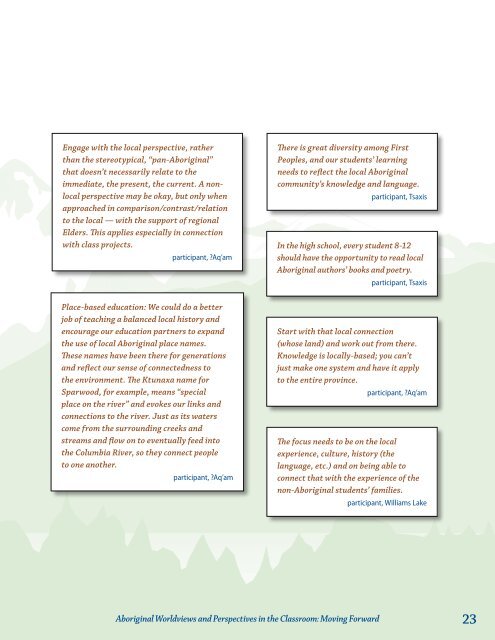Aboriginal Worldviews and Perspectives in the Classroom
Ab-Worldviews-and-the-Classroom-220mzng
Ab-Worldviews-and-the-Classroom-220mzng
Create successful ePaper yourself
Turn your PDF publications into a flip-book with our unique Google optimized e-Paper software.
Engage with <strong>the</strong> local perspective, ra<strong>the</strong>r<br />
than <strong>the</strong> stereotypical, “pan-<strong>Aborig<strong>in</strong>al</strong>”<br />
that doesn’t necessarily relate to <strong>the</strong><br />
immediate, <strong>the</strong> present, <strong>the</strong> current. A nonlocal<br />
perspective may be okay, but only when<br />
approached <strong>in</strong> comparison/contrast/relation<br />
to <strong>the</strong> local — with <strong>the</strong> support of regional<br />
Elders. This applies especially <strong>in</strong> connection<br />
with class projects.<br />
participant, ?Aq’am<br />
There is great diversity among First<br />
Peoples, <strong>and</strong> our students’ learn<strong>in</strong>g<br />
needs to reflect <strong>the</strong> local <strong>Aborig<strong>in</strong>al</strong><br />
community’s knowledge <strong>and</strong> language.<br />
participant, Tsaxis<br />
In <strong>the</strong> high school, every student 8-12<br />
should have <strong>the</strong> opportunity to read local<br />
<strong>Aborig<strong>in</strong>al</strong> authors’ books <strong>and</strong> poetry.<br />
participant, Tsaxis<br />
Place-based education: We could do a better<br />
job of teach<strong>in</strong>g a balanced local history <strong>and</strong><br />
encourage our education partners to exp<strong>and</strong><br />
<strong>the</strong> use of local <strong>Aborig<strong>in</strong>al</strong> place names.<br />
These names have been <strong>the</strong>re for generations<br />
<strong>and</strong> reflect our sense of connectedness to<br />
<strong>the</strong> environment. The Ktunaxa name for<br />
Sparwood, for example, means “special<br />
place on <strong>the</strong> river” <strong>and</strong> evokes our l<strong>in</strong>ks <strong>and</strong><br />
connections to <strong>the</strong> river. Just as its waters<br />
come from <strong>the</strong> surround<strong>in</strong>g creeks <strong>and</strong><br />
streams <strong>and</strong> flow on to eventually feed <strong>in</strong>to<br />
<strong>the</strong> Columbia River, so <strong>the</strong>y connect people<br />
to one ano<strong>the</strong>r.<br />
participant, ?Aq’am<br />
Start with that local connection<br />
(whose l<strong>and</strong>) <strong>and</strong> work out from <strong>the</strong>re.<br />
Knowledge is locally-based; you can’t<br />
just make one system <strong>and</strong> have it apply<br />
to <strong>the</strong> entire prov<strong>in</strong>ce.<br />
participant, ?Aq’am<br />
The focus needs to be on <strong>the</strong> local<br />
experience, culture, history (<strong>the</strong><br />
language, etc.) <strong>and</strong> on be<strong>in</strong>g able to<br />
connect that with <strong>the</strong> experience of <strong>the</strong><br />
non-<strong>Aborig<strong>in</strong>al</strong> students’ families.<br />
participant, Williams Lake<br />
<strong>Aborig<strong>in</strong>al</strong> <strong>Worldviews</strong> <strong>and</strong> <strong>Perspectives</strong> <strong>in</strong> <strong>the</strong> <strong>Classroom</strong>: Mov<strong>in</strong>g Forward<br />
23


